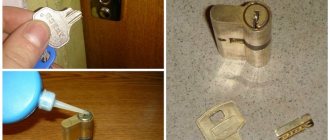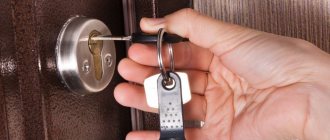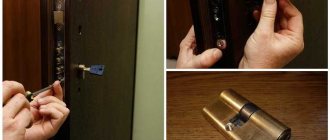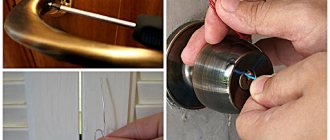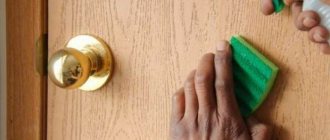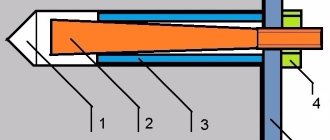Let's assess the current situation
First, it is important to stop panicking, then you will be able to sensibly assess the situation:
- if you don’t have the skills to handle the lock mechanism, then you should put things off and wait for a specialist, rather than try to deal with the breakdown yourself, which can only make things worse;
- if you understand something about the lock mechanism or have installed or changed it without outside help, then you can try to fix the problem on your own;
- if there is no time to wait for a specialist, then even a person who does not understand anything about it will try to solve the problem on his own, we will try to help you so that the situation does not get even worse;
- You may have to ask your neighbors for some tools if yours are left in a locked apartment; if the door remains open and the key is stuck, then, of course, it will be easier for you, since all the necessary tools will most likely be found at home;
- If you manage to pull out the key, then don’t rush to insert it again, it’s not a fact that it won’t get stuck there again and this time you won’t be able to pull it out.
Adviсe
Carry with you the phone number, business card of a special service or technician who can help in the event of such force majeure. This way you will save your nerve cells and can quickly fix the problem. And at worst, when there are no facilities at all, there are no neighbors, and it’s cold outside, the door can be broken down. But only if it is wooden: a metal model can hardly be handled alone, especially if it opens outwards.
We also recommend that you read the information on how to recode the lock on your front door.
How to remove a key stuck in a keyhole
Let's start with the easiest way. It’s even better if you didn’t have time to lock the door and you have access to the apartment - in the opposite situation, you will need the help of your neighbors to ask for the necessary tools and materials.
We take out the key from the cylinder or lever lock:
- You will need the famous liquid - WD-40, which removes dirt and rust, has lubricating properties and excellent penetrating ability. It needs to be poured into the keyhole using a syringe or syringe.
Attention . Do not use soft materials with lint, such as cotton pads or cotton swabs, for lubrication. Small particles from them can completely jam the mechanism and then there will be no point in further actions.
- Wait about 10 minutes for the liquid to take effect.
- Try to turn the key lightly in both directions, without using too much force.
- Are your hands slipping and nothing works? Try turning the key using pliers, but do it very carefully, control the pressure so as not to break the mechanism.
- If you manage to remove the key, do not rush to use it again; it is best to completely replace the lock.
Tools and accessories
To get the key out of the lock, we may need tools and devices such as:
- syringe with needle;
- screwdriver;
- drill;
- hammer;
- hairpin;
- pliers;
- pliers;
- tweezers;
- jigsaw;
- awl;
- self-tapping screw;
- grinder saw and others.
You won’t need absolutely all the tools at once, but three or four of them will definitely come in handy.
When trying to open a long-suffering door, do not forget that the secret of the lock must be handled very carefully.
If the key could not be retrieved
If WD-40 did not help and the key did not budge, then more decisive action will be required: the use of physical force or disassembling the mechanism.
If the lock is cylinder and the door is closed, then follow these steps:
- the lock should be hit with something heavy and blunt;
- the right blow will cause the larva to break into 2 parts, this is how it should be;
- Next, the lock tongue must be moved using a screwdriver; after such actions, the lock will have to be replaced.
If the key is in an open door:
- In this case, there is no need to use blows, find a screwdriver, it is better if it is negative;
- Next, you should unscrew the bolts holding the lock, remove the lock mechanism, then unscrew the fastening element that prevents you from removing the key;
- With this option, there is no need to replace the entire mechanism; only the cylinder will need to be replaced.
Opened door
When the problem arose before the door was closed and the key turns but does not come out, here you can quickly and painlessly solve it. To do this, you need to remove the “core”. At the end of the door, where the lock itself is installed, there is a cylinder fastening element on the bar (a long screw with a flat head). Unscrew it with a screwdriver, then, turning the key, find the position of the open bolts of the lock - press on the cylinder on the back side of the door, where the handle is. The cylindrical element should fall out easily. Buy it and insert a new core using the same method.
More serious measures
If the door is closed, and you need to get into the apartment now, there is no time to wait for a specialist, the previous methods did not help, then you will have to use radical measures, this requires physical strength:
- Try to knock down the door. This method will help if the door is wooden, but modern metal versions will most likely be impossible to knock out.
- Cut the loops. In this case, you will need a grinder designed for metal objects. The loops must be visible; if they are hidden, then nothing will work. The lock bolt can be cut.
- Take a drill, a metal drill and drill out the locking mechanism.
The use of such methods will require further replacement of the lock or door, so it is better not to use them unless absolutely necessary.
If you have time, wait for the help of a specialist.
Causes of problems
The most common difficulties:
- The tongue cannot close. The source of the problem is the small size of the response hole. It needs to be enlarged or the plate moved a little. Another reason could be a door that is warped due to frequent use. The mechanism wears out and needs to be adjusted.
- Difficulty opening the door when it is blocked due to a misaligned lock or door frame. In this case, the problematic part is adjusted.
- The key gets stuck, is difficult to turn, or cannot be inserted. This is more common on metal doors. This happens due to debris getting into the lock or some of its parts shifting. To get rid of the problem, it is disassembled, cleaned and lubricated.
- The lock is jammed - there is a problem with the condition of the cylinder. The seal needs to be repaired or replaced. In some cases, it is better to install a new lock if the old one is worn out and ancient.
Other reasons for problems with the lock:
- factory defects in the mechanism;
- rare washing and lubrication;
- using the key for other purposes (opening a bottle, packaging);
- frequent opening of the door with force;
- worn parts in the lock;
- duplicate key of poor quality;
- incorrect initial installation of the lock;
- a wooden door can become damp and swell.
If the key needs to be removed from the padlock mechanism
In such cases, people often immediately act radically - they cut the lock shackle with a hacksaw. This option will help 100% if it’s not difficult for you to change the lock and you have a hacksaw available. If you don’t have a tool or don’t want to cut the lock, then you need to perform actions similar to those taken with the mortise mechanism, since the reasons for the breakdown are almost the same.
Necessary actions:
- lubricate the mechanism well with kerosene or WD-40, wait a little and try turning the key, as in the previous methods;
- At cold temperatures, such locks can jam, then heating the lock can help.
The main culprits of the problem
In rack and pinion locking devices, you do not need to turn the key when opening, so the problem is not relevant for them. Due to the structural features of the mechanism, cylinder and lever types of devices most often break.
The lock does not work Source waysi.ru
A piece of the key remained in the lock
What's worse than having a key stuck in a lock? That's right, the key that was in it broke in half. Such situations happen when you handle the key carelessly, when trying to pull it out when it is stuck, or if the lock or key is of poor quality.
Try the following techniques:
- Pour any lubricating liquid into the keyhole: kerosene, oil, WD-40, silicone, etc., leave for 10 minutes and try to pull out the key piece. To do this you will need pliers or tweezers.
- If the metal from which the key is made is of high quality, then use a magnet.
- Try inserting a jigsaw blade into the keyhole, press it against the key fragment and pull it towards you, try to pull the fragment out enough so that you can hook it with pliers or tweezers.
- An interesting way is a lighter + glue stick. It can only help if the stuck piece is in a neutral position.
Types of locks
By type of key:
- cylinder - with a small key with protrusions and notches;
- level key – a long key with “wings” on the edges;
- Phillips - with a key similar to a Phillips screwdriver;
- disk - the key is small and semicircular with notches.
By type of insert:
- the overhead lock is installed on the door leaf, closed with a key from the outside, and a latch from the inside;
- mortise is built inside the door, the handle controls the tongue;
- A padlock is installed separately from the locking element and is used for garage doors or gates.
The most popular are mortise lever locks.
Reasons why a key might get stuck in a lock
It is necessary to know the reasons for such situations, this will allow them to be avoided.
Often the key becomes hostage to the lock due to the fault of the person who uses it:
- the key can only be used for its intended purpose; you cannot use it to open bottles, cut something, etc.; otherwise, sooner or later it will get stuck in the keyhole;
- if you open the lock with force, you will soon break it or the key;
- You cannot slam the door regularly and forcefully, otherwise you will not be able to open it;
- debris that gets into the keyhole causes the key to get stuck in it;
- the door was installed incorrectly or the door leaf gradually warped;
- the locking mechanism was operated in conditions of high humidity without receiving proper care;
- the original key was lost, and its duplicate turned out to be of poor quality.
Often the cause of breakdown is the poor quality of the lock itself or the key to it. The pins in the lock are often made of soft metal; when the key hits the keyhole, they move and clamp it. To prevent such situations from happening, you should buy reliable mechanisms from trusted manufacturers.
We understand the reasons for the key getting stuck
Every person has a situation in their life when the key is stuck in the lock and they cannot close or open the door.
Or the key is difficult to remove from the lock of the door of an apartment or house. Some people get it quickly themselves, without resorting to the services of a specialist or information from the Internet, while others do the opposite. If you belong to the second type of people, then do not rush to call customer service right away, read this article first and use the tips given in it. Why does the key get stuck in the lock? What causes of failure can be identified when such a situation occurs?
- the key wears out due to improper use. For example, bottles are often opened with a key or cans are opened with it. As a result of such machinations, the key may lose its former shape and become crooked;
- wear or aging of the lock;
- micro contamination or ingress of debris and dust into the secret mechanism of the lock;
- opening the lock with a foreign object;
- use of low-quality keys.
What should you do to avoid getting into such situations?
In the previous paragraph, we identified all the reasons that can cause trouble with a stuck key. In general, everything is clear; it is important to use the mechanism and key correctly so as not to get into such difficult situations:
- We use the key only for its intended purpose.
- Keys and locks are not toys for children; buy toy mechanisms for your children.
- Only the key intended for it should be inserted into the key hole and nothing else.
- If you lose the original key, order a duplicate from a reliable, trusted place; it’s better to overpay than to install a new mechanism.
- The door should be opened and closed very carefully, without impacts, force, etc.
- If the door leaf is skewed, it should be corrected immediately by calling a specialist to avoid additional problems.
- The keyhole must be cleaned regularly. This is done using a syringe or syringe, which is used to pour kerosene or motor oil into the mechanism. We continue cleaning by inserting the key into the keyhole several times and pulling it out, wiping off any dirt that has stuck to it. To ensure that the oil evenly lubricates each part of the mechanism, you need to turn the key several times.
Important . Do not leave small children alone at home; even to take out the trash, the lock may not open, and the child will be very scared.
If you are not sure that you can cope with the current situation on your own, then seek help from a specialist.
The lock and key on the door leading to an apartment or house have become so familiar to people that they do not pay attention to these mechanisms. We do not think when we open or close the front door, doing everything mechanically on the run, often ignoring accuracy. And there is no question of monitoring the lock mechanism at all; no one ever thinks about it. Then, one unlucky day, we receive a key that is stuck in the keyhole or, even worse, a piece of it.
If such a situation occurs, it is important not to panic, as it will only worsen the situation. If things can be postponed, then wait for the master; it is better to pay him for the work and, if possible, preserve the locking mechanism, than to waste your energy and break the mechanism in the absence of experience.
Preventive measures
In order to ensure that there is no need to remove a stuck key from the mechanism in use, and the doors open every time without squeaking or any problems, it is necessary to regularly inspect the lock for corrosion and carry out its treatment. One of the main procedures is considered to be high-quality lubrication of the mechanism.
To do this you will need to perform the following manipulations:
- The cleaning liquid is poured into the lock. It is based on kerosene, which will help you easily remove all types of contaminants.
- The key is inserted into the well, and after it is removed, it is wiped dry to remove the removed dirt.
- Similar actions must be repeated several times.
- Pour machine oil over the mechanism and turn the key several times.
- All parts are wiped dry.
If you treat the fittings with the utmost care, you can prevent the slightest damage and avoid unpleasant situations associated with the lock getting stuck in the future.

